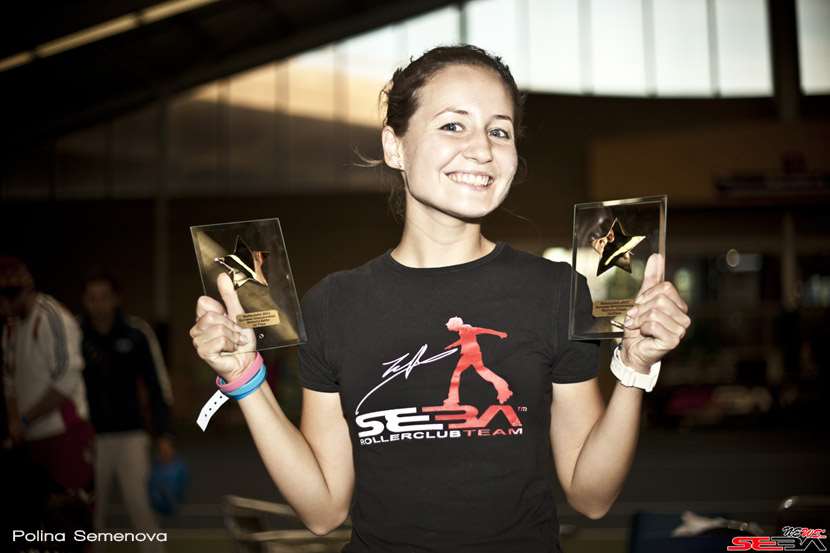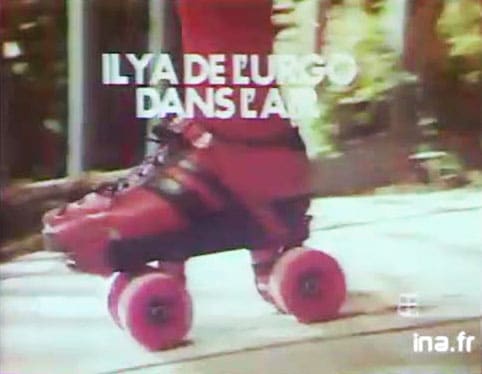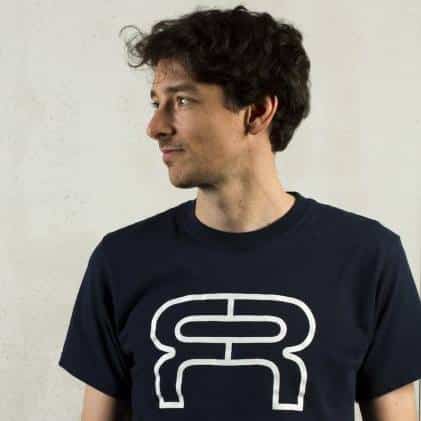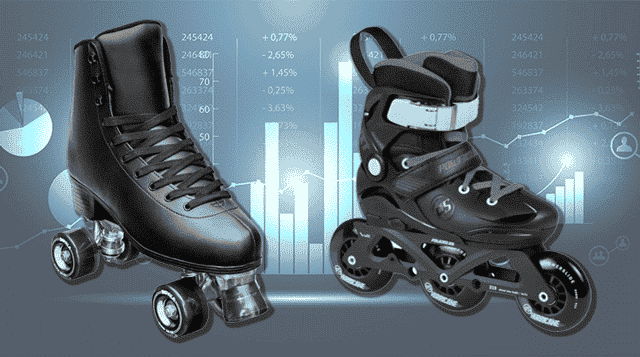Is roller-skating a childish pastime?
Years passing, we could have believed that the reputation of the roller would have evolved a lot. Nevertheless, in mind of numerous persons, this practice evokes more a leisure than a real sport. Some consider it as a totally childish pastime. Others are even surprised when they learn the existence of speed-skating race. Roller-skating : childish pastime or real sport?
Par alfathor

The image of roller-skating through history
The origins: a practice of originals and eccentric
 The date of birth of roller-skating stays rather vague. The historic documentation is not sufficient. One attribute the invention to John Joseph Merlin (1735-1803) native of Huy, in Belgium (Nieswizski, 1991).
The date of birth of roller-skating stays rather vague. The historic documentation is not sufficient. One attribute the invention to John Joseph Merlin (1735-1803) native of Huy, in Belgium (Nieswizski, 1991).
He had the idea, in 1760, to adapt the ice-skates to the ground by fixing metal rollers to a wooden plate. Merlin was a specialist of the mechanical machines. This prototype possessed aligned wheels. During a worldly evening in London, Merlin presented its invention. Only a few originals practised roller-skate at the end of the 18th century.
Numerous inventors follow Merlin
A few years after Merlin, Maximilliaan Lodewijk Van Lede, student of Brugge academy created a pair of these strange machines in 1789. He was a sculptor medal maker of the Paris Academy. Altogether, all these inventors stemming from the upper middle class.
In 1819, French Petibled, mechanic, conceived a new model of inline skates and patented it. Numerous inventors follow one another afterward: John Spence (Scotland), Robert John Tyers, August Löhner, Legrand, Jean Garcin. All the inventors whom we quoted are European and were also ice-skaters.
Garcin built the most elaborated in-line skate ever seen and named it « cingar » (anagram of his name). He was a famous french ice-skaterunder the First Empire and the Restoration, he wrote a book
« The real skater, or principles of the art to skate with grace (1813) »
There are indications showing that the practice confined only to a minority of people. Some of these were considered as eccentrics (see the illustration from Sam Nieswizski’s book « Rollermania »).
« It is with skates with three aligned wheels, that, in 1849, an original amazed the curious onlookers of the place of Concorde »
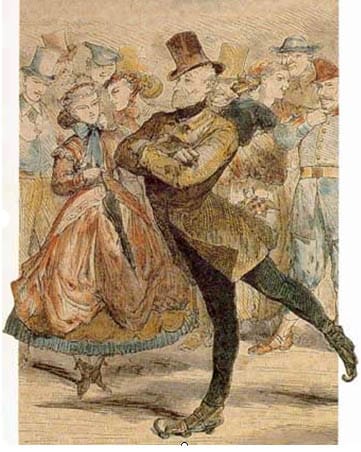
Roller-skating spread at first in the upper classes
In 1849, roller-skating goes to the Opera withThe roller skate rises on boards. An opera of Meyerbeer, » The prophet » took place to the theater of the Nation. It contained skaters’ ballet. Legrand managed the Opera. Afterward, the dancers understood the interest of such an invention. The upper-classes were the first to discover roller-skating.
Nieswizski quotes characters of the aristocracy as main followers: in 1820, the Knight of Saint Georges in France to the place « Palais Royal » in front of Le Louvre…
« At first, people who skated on ice were aristocrats. People who skated in Paris came with an eyeglass, a top hat, with a stick, for the elegance but also for the balance. And when the first quad skates appeared in the 1870s, it was the same who uses skates in the absence of ice. Thus, it was a very aristocratic sport. The aristocracy and the upper middle class. »
(Sam Nieswizski – 2003)
In the 19th century, the leisure activities concern only a small fraction of the society. As Thorstein Veblen said, they belong to the « leisure class ».
The upper-classes generally does not really work but benefits from the work of the other social classes. The leisure activities, considered as an unproductive occupation allow to distinguish themselves, to compete, to show their superior membership. They are in a logic of ostentation.
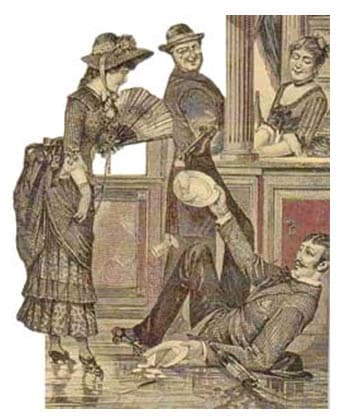 Picture n°2 : Plimpton skates : 1863 (Nieswizski, 1991, p. 25)
Picture n°2 : Plimpton skates : 1863 (Nieswizski, 1991, p. 25)
Gradually, roller skate spreads out in Europe. In London, in 1823, Tyers open a lot of schools of skating in disused tennis courts. Robillon, based another school in Bordeaux, Garcin opened one in the Villette (Paris). The movement accelerates with the arrival of the quad skates (with axles) during the second half of the XIXth century.
It is a general sociological tendency of the sports to spread from the superior classes to the lower social classes.
The in-line wheels reigned until 1863, date of the appearance of the quad skates. The traditional skates or the quad skates, more handy and produced to an industrial scale, quickly darkened the in-line skates. They spread, at first in North America, then in Europe.
« When the first quad-skates arrive in the 1870’s, it was the same people who skated on the ground when there was no ice. Thus it was a very aristocratic sport. The aristocracy and the upper middle class. «
(Sam Nieswizski – 2003)
In 1876, one already spoke about the fashion of skating in Paris: < i > » the ‘skatinage’ is fashionable. it advantageously replaced the velocipede. (…) One ‘skatine’ everywhere, it is a madness. (…) ‘Skatiners’ practise their pleasures only in dedicated places, and can only hurt between them. « The skaters ride in closed circles.
It is only later that the skating will extend in the other classes of society. During a long period, the roller-skate was only practised only in closed and smoother places: skating-rinks. It is probably one of reasons of the fast enfeeblement of this fashion. Two other possible causes could be the prohibitive cost of access to skating-rink and disparities of time for leisure activities (Veblen, 1899).
Of the height downward, roller-skating touch the other social classes
Sam Nieswizski confirms this theory:
« And then it began to become more democratic, to become a more popular sport. Those who frequented skating-rinks on the left side of the Seine (the river which divided Paris in two parts) were students. Theu came to enjoy themselves. In the rest of Paris, it was people who frequented popular dancing. It was in 1876 or 1879. »
(Sam Nieswizski – 2002)
During this period, the number of skating-rink exploded in the world. The entry to skating-rink was sometimes subjected to particular conditions as the cooptation. When the practice spread in the popular classes, the upper classes were not able to prevent this phenomenon. Thus, the social distinction depends on the place the people went to skate. In Paris, for example, we can notice a difference of social classes between the left and the right side of the Seine.
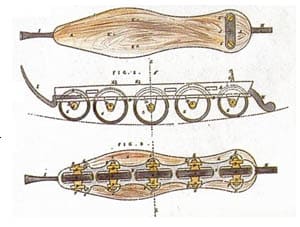 Picture n°3 : Tyers Skate in 1828 (personal collection of Sam Nieswiski)
Picture n°3 : Tyers Skate in 1828 (personal collection of Sam Nieswiski)
« (..)It was saucy middle-class persons, not « traditional » middle-class persons for the fashion of 1876. Later, another fashion appeared in 1914. It began in the same way with aristocrats and then it became more democratic. To practise sport people put caps, short jackets, women wore skirts breeches… and then, very fast, it became a little a hooligan.
There are people who came to flirt in an unrefined way, there were fights. I noticed by discussing with other people who studied the other sports that it was a general phenomenon. Sports begin aristocratically, become more democratic and become a hooligan. Here are the main lines, roughly speaking. »
This truth expressed by Sam Nieswizski is a turned out sociological fact. He completes his argumentation by describing us all the classes of society:
« The students were more relax. The persons of the middle class, it was rather the top hat, the eyeglass… the girls got dressed as for the ice sports while it was warm, with muffs of fur. In fact, it is very recent that the roller skate is really autonomous. It was an imitation of ice-skating for a long time. A sort of replacement. »
And nevertheless, in some years, the skate fell again into the forgetting. One wait till 1910 to see it born again. Once again, it is a technological innovation which boosted the fashion: skates-cycles.
Generally speaking, the return of the sports practices is often bounded to a major technological innovation.
Then, a new cycle started at the end of the Second World War and finally the during the 70s and the 80s. The traditional skates reappeared. One notice a cyclic return of the roller through times, all 30 or 40 years.
The return of roller-skating in the 80s : An infantile and marginal practice
The legend says that roller-skating returns thanks to the skateboard. The American manufacturers would have had an enormous stock of skateboard trucks and wheels (unsold articles). It would thus have been necessary « to recycle » all this material.
« The Inline-skate was reborn in the United States during the 80s, but slowly. I went to Central Park in 1983, i saw only some in-line skate but it spreads throughout France and really took off in 1993, it is the precise date. »
This return of the practice is not a fate, it is due to several factors: the attraction for the « Californian sports » (Alain Loret), the environmentalist questions and the birth of the « fun » culture. The period also coincides with the success of the Disco. We shall think in particular of the film « Roll’Bounce » which shows the atmosphere of the period in the United Stats of America.
The practice in the 80s by Serge Rodriguez
« In the 80s, Quad-skating is for the children a way of enjoying themselves. For the adults, it is either a way to continue an ice-skating practice, or to realize a child’s dream. Continue to practise skate when you are adult (…) is also a marginal behavior. As soon as one are adult and have a pair of skates, one are a bit excluded and considered as a child. » (Serge Rodriguez – 2002)
This image of marginal is still alive today. Roller-skates are often offered to children for Christmas or for their birthday. The adult practice is often inconceivable, even shameful.
« In the 80s, numerous adult skaters who were buying quad skates said that it was for their child because they were ashamed. » (Serge Rodriguez – 2002)
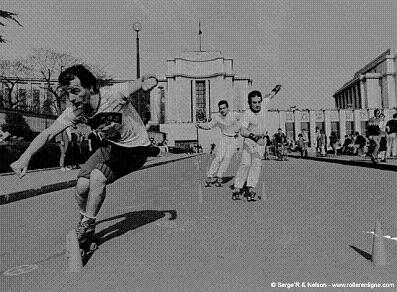
« I knew people who skated and who hid it to their neighbour. They left from their home by foot and put their skates 500 m farther. So their neighbours could not see them. » (Serge Rodriguez – 2003)
Next to the Montparnasse tower, riders met to practise the jump, the slalom or to organize wild rides in Paris. A misunderstanding and an incomprehension of the practice settled down in this period. We can say that during around ten years, the roller stayed in sleep mode, until the arrival of the inline skates which invaded the market and made the practice exploding.
Nevertheless, the return of the inline-skates did not change at once the image of the roller. Skaters were still considered as extraterrestrials.
In 1992, the rink-hockey was presented to the Olympics of Barcelona, at instigation of Juan Antonio Samaranch, then president of the IOC. Rink-hockey is one of the most ancient practices in competition. This event gave a more serious image to our sport.
The explanation of the return of roller-skating in France and Europe
One attribute the return of roller-skating in France to the strikes which paralyzed the country in 1995. According to the legend, the country would have been so paralyzed that numerous persons searched an alternative solution to move daily: by foot, with a bicycle or with roller-skates. The fashion was launched…
The practice of the roller partially lost its distinctive and marginal dimensions inherited during the beginning of the 90s.
As C. Pocielllo (1981) explains:
« Invented imported or promoted by groups culturally facilitated, the new sports will undergo a « popularization » and a progressive disclosure and, although differential, generally inevitable ».
At this moment of the contemporary history, roller-skating hardly arrives from the United States. On the other side of the Atlantic, 29 to 30 million persons regularly put their skates. In France, only some crazy and nuts guys play to go down the Trocadero at top speed. They also occupy the paving stone Montparnasse. The famous ride of Friday evening, the « Friday Night Fever », is still growing.
The organizers of the friday rides had difficulty legitimizing their practice. There were many conflicts with the authorities. The mayors and the prefects saw it as a sort of political or social demonstration. It floated then a perfume of incomprehension. The national press asked the same questions and reflected on the causes of this phenomenon. The weekly rides were under the spotlights of the media, in particular the « Express ». It was a real opportunity for roller-skating. The early adopters saw their rides growing and growing. The were followed by employees, and lots of other skaters stemming from varied social classes.
De leur côté, les fabricants, à grand renfort de publicité tentent de pousser le phénomène. Ils utilisent le roller agressif comme figure de proue de leur communication. The manufacturers tried to push the phenomenon with a lot of advertising. They used the aggressive skating as figurehead of their communication. 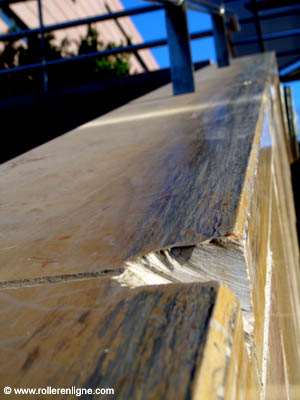
An uneven consideration according to the practices
In the 90s, the public puts all the skaters in the same basket. The distinction between fitness skaters, slalomers or aggressive skaters is vague, even non-existent. As a result, all of them have a confused image of rebel or vandal. A lot of mayors decided to publish municipal orders forbidding the practice of roller and skateboard in cities.
Nevertheless, the « stunt » (aggressive skating) keeps growing, despite all. The shock with the authorities is a little rougher. Riders are rejected during this period.
The mayors try vainly to forbid the practice in numerous public places. They try to « park » the skaters in dedicated places: the skateparks. Here again, the authorities misunderstand the motivations of skaters and do not hear their requests. The cities build skateparks without consulting the riders. The spot are deserted.
The stubbornness of riders brings to delirious practices where cities create notches in their low walls or raise fragments of metal on urban furnitures to make structures impracticable.
A better fate for speed-skaters
Speed-skating knew a more favorable fate. The clothes of skaters is more common. They look like cyclists. They wear more recognizable and more reassuring signs and already known by all. The fact they wear a helmet is considered as a proof of responsible behavior. Nevertheless, on the road, skaters and packs still have difficulties in acquiring a legitimacy. The car drivers often honk or roar, furious of seeing their space used by a new strange and underestimated practice. Speed-skaters got gradually the respect of the cyclists who became aware of the swiftness of roller-skating.
More and more people daily use their skates to go to work. The police hesitates, not knowing if it is necessary to condemn or to let make, if the rider must use the road or the pavement. The law has no real answer for the moment in a lot of countries (except in Belgium). It leads toridiculous situations where the police asks to a skater in the open countryside to ride on a non-existent pavement.
In the cities, the skaters juggle between bicycle paths, pavements, roads and bus ways to circulate easily in the traffic. The usual skater does not really know where he has to ride. As a result, it depends on the good will of each skater and according to the humors of the authorities.
It was necessary to wait for the last 5 years to see the authorities listening the skaters and reflecting on their needs. This case is complexe. Roller-skating embraces various practices which are not equally considered by the population and the authorities. There is still a lot of work to do to change the image of roller-skating. Numerous mayors continue to build skateparks in their municipalities without consulting their users and determinate their real needs.
The Olympic question: a necessary passage to reach maturity?
Nevertheless, we noticed an improvement of the perception of roller-skating these last years. The road to make is still considerable. For example, France is late regard to its European neighbours.
How to acquire a legitimacy and a real sporting status in mind of the public? Several conditions seem necessary to us:
– It is absolutely necessary to enter in the exclusive club of the IOC (International Olympic Committee). The integration of the Olympic movement is a condition to image change the image of roller-skating, to make it considered as a real sport.
– In the same logic, the quite powerful television would facilitate the recognition of the roller in the world.
– Roller-skating must be quickly considered as a real transporting solution find its place in the laws as bicycle did.
Since 1992 and the presentation of Rink-hockey in the Olympic Games in 1992, roller-skating did not succeed in entering the Olympic Circle. Furthermore, the number of represented practices decreased from 28 to 26.
Let us be not too pessimistic either, each years, World Championships gather more and more nations. We reach about fifty countries represented to Anyang in China in 2006. In 2007 and 2008, the Worlds in Colombia and Spain gathered around 60 nations. 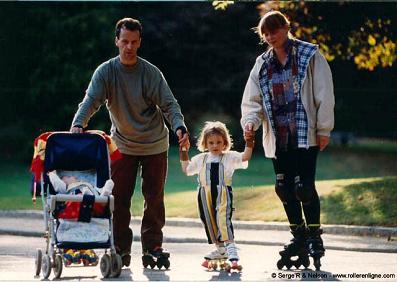
Puerility: a french speciality?
If roller-skating has not enough credit in France, there are countries where it stood out as one of the major disciplines : In Colombia, roller-skating reached summits, approaching slowly scores realized by the god football and queen Formule 1. In Switzerland and in Germany, races gather thousands of skaters… without speaking about new Asian events in Korea and in China!
Conclusion
We can say that roller-skating followed the same road as many other sports. It spread from the upper social classes to the popular classes during the last 200 years. Strangely, the childish dimension of the skate does come from its origins, but from the beginning of the 20th century.
Today, the mentalities evolve slowly according to the nature of the considered practice : Of a complete refusal, the roller seems to find gradually its place in the townscape. If it still has no real status in some countries, we can hope that the examples of European countries will give a mature image to this sport, so old and nevertheless so young…
Links
Photos : Alexandre Chartier and Serge Rodriguez
Thanks to Sam Nieswizski,
Serge Rodriguez,
Boramy Thong


